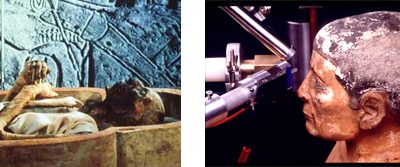Radioactivity and our cultural heritage
Nuclear techniques are used in studies of our cultural heritage. Before being exhibited in a museum, the vestiges of past civilisations must be identified and analyzed. The objects authenticity is guaranteed by these analyses, which can also supply as much information as possible on their archaeological and historical origins. On the other hand, their old age has made these objects very fragile : They must be treated and protected so that future generations can still admire them. Here are several examples of applications :
Ashes which were found in the Chauvet grotto have been analyzed. Their content of carbon -14 has helped to date the period when the grotto was inhabited by prehistoric men as early as 35 000 years ago.
A medieval wooden statue was coated with a resin which was hardened by irradiation. Thanks to this treatment it can finally be shown to and admired by the public.
At the Carnavalet Museum in Paris neolithic dugouts found along the banks of the Seine are exposed. One of them was consolidated by irradiation, so there is no more risk of it falling to dust.
The mummy of a great pharaoh travelled from Cairo to Paris. Before returning to its country it was irradiated by gamma rays in order destroy all the micro-organisms which were attacking It.
The paintings exhibited in the Louvre are not copies. AGLAE, a small accelerator in the Center for research and restoration of the French museums, has checked their authenticity.
On the Giza plateau, physicists use atmospheric cosmic muons to scan the inside of the Cheops pyramid and discover unknown cavities.

Sterilization and painted object analysis
On the right, sterilization of the Ramses II mummy at the french Commissariat à l’énergie atomique (CEA) ; On the left, ion beam analysis of an eye detail of an Egyptian scribe at the Louvre museum
© CEA et musée du Louvre
ACCESS TO CHAPTERS : SUMMARY
– Atoms for museums – Nuclear techniques in museums :the AGLAE accelerator of the Louvre Museum, the PIXE and RBS analysis techniques
– Objects analysis – Awareness of our heritage : Identification and origins of materials and components, analysis of fabrication techniques
– Preservation techniques – Objects conservation : Preservation methods, strengthening of crumbling artefacts, sterilisation of ancient relics.